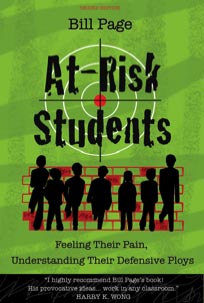|
 |
| Teachers.Net Gazette Vol.6 No.4 | April 2009 |
Subscribe for free home delivery |
|
At Risk Students: Victims of Miseducation and Failure At-risk students are victims of circumstances. They can’t pull themselves up by the bootstraps – they have no boots. | ||
| by Bill Page www.teacherteacher.com Visit: www.At-RiskStudents.com for Bill’s free monthly newsletter Continued from page 1 April 1, 2009 |
||
 Through elementary school the kid’s failure problem is persistently passed to the parents, who must teach their child or pressure the child to study harder and to “try,” “work harder,” and conform. When the school tasks get too difficult and parents cannot teach or pressure the kid sufficiently toward success, they give up in exasperation. Parents cannot learn for their child, so they continue the same pressure, threats, and intimidation used by the school, usually to the breaking point in family relationships. A student failed at school and pressured relentlessly and futilely at home has few options remaining for acceptance, success, or belonging. Failed Students Rarely Recover Schools create the problems of the mismatch and schools are the only ones that can solve them. The age-grouped, lock-stepped, grade-level, preordained curriculum is a bureaucratic tradition and is distributed through twelve school years unabated and unquestioned. Once a student begins his/her schooling behind, or falls behind, it is almost impossible for him/her to catch up. Embarrassed by their failure, dreading and avoiding subjects in which they cannot succeed, they suffer trepidation, embarrassment, unpleasant, boring classes with no hope or relief in sight and with increasing friction and frustration at home. Once they have “made their bed” they cannot reasonably recover. It is only by intervention by an authority figure that they might escape their pain and misery. Adapt the Curriculum to the Learner So long as there is an unreasonable mismatch between the preordained school curriculum and student preparedness, there will always be students who are unable to achieve, who are embarrassed, who struggle, who fail, and who are forced to defend their dignity, psyche, and worth instead of to learn. Thus, the only alternative to the at-risk student’s dilemma is one that adapts the curriculum to the learner instead of compelling the learner to adapt to inappropriate school lessons. Our education system is an archaic, bureaucratic nightmare of policies rigged against effective teaching and efficient learning. Educators know that groups do not learn. Only individuals, in a group might learn, but not when the grouping is based on chronological age and the teaching is determined independent of each learner’s needs. Educators know that there are individual differences in interest, attitude, readiness, feelings, prior knowledge, backgrounds, learning style, personality, and learning skills; but school policy makes few, if any, allowances for those differences as classes move through their predetermined schedule. The Solution to the At-Risk Problem Must Come From Policy Makers The solution to the problems of students at-risk, dropouts, failures, “troublemakers”, and the embarrassing achievement gap requires that schools offer students appropriate, useful, worthwhile courses and learning objectives. Dedicated, well meaning teachers and the frustrated, victimized students must be offered a relevant and appropriate curriculum--that is the only viable alternative--it lies with policy makers--outside of teacher control. One solution may be for a public outcry, but the public needs to understand the problem. And teachers can help. While teachers cannot make policy, fortunately, they can change their part of the student-teacher relationship. Teacher Study Groups have emerged as effective procedures for helping teachers change their attitude, understanding, and treatment of problem learners. Teachers cannot improve or change their teaching of at-risk kids without first improving and changing the beliefs on which their teaching of failing students is based. Teachers Are the Difference: Reflection Makes the Difference Teams of teachers in schools focus on their beliefs and assumptions as the causes of behavior, rather than on behaviors, which are symptoms of those beliefs. Changing beliefs requires teachers to reflect on their beliefs as a means of changing their behavior. Behavior is always purposeful to the behaver; teachers need to learn to deal with the causes, not the behavior. Until teachers have a meaningful opportunity to reflect on how school policies ensure that kids most unloved and unlovable get the least acceptance, they will continue to contribute to the intractable problem rather than reduce its deleterious effects. With joy in sharing, Bill Page Your comments and questions are always welcome and will be answered. Write to billpage@bellsouth.net Bill’s article in the February, 2009 Gazette, "Teacher Study Groups: Taking the Risk out of At-Risk" describes his method of classroom teachers making a difference. At-Risk Students, Second Edition 2009, has 31 chapters designed for teacher reflection and Faculty Focus Groups. Visit www.at-riskstudents.com for further information
At-Risk Students: Feeling Their Pain, Understanding Their Defensive Ploys. “Insights and strategies for kids who can’t, don’t, or won’t learn, try, follow procedures, cooperate, or behave.” At-Risk Student: One whom teachers cannot motivate, interest, control, or teach via traditional techniques. The term “At-Risk” refers to being at risk of failure, but it has come to mean “at-certain” of not being taught. At-Risk Students is currently in its Second Printing and was released January 2009, 280 pages, $24.95 including P & H, Educational Dynamics Publishers, Nashville, TN, Visit www.TeacherTeacher.com for information, preview, and orders. Satisfaction Guaranteed. Send to billpage@bellsouth.net for quantity discounts for Teacher Study Groups. My favorite article, “Insights and Strategies for Kids Who Can’t, Don’t, or Won’t even try to Learn, Cooperate, or Behave can be read or downloaded free at: www.teacherteacher.com . Teachers can sign up there for my free monthly newsletter: At-Risk Student Advocate. “To the world you may be just one person: but to one person you just may be the world.” | ||
|




 Bill Page, a farm boy, graduated from a one-room school. He forged a career in the classroom teaching middle school “troublemakers.” For the past 26 years, in addition to his classroom duties, he has taught teachers across the nation to teach the lowest achieving students successfully with his proven premise, “Failure is the choice and fault of schools, not the students.”
Bill Page, a farm boy, graduated from a one-room school. He forged a career in the classroom teaching middle school “troublemakers.” For the past 26 years, in addition to his classroom duties, he has taught teachers across the nation to teach the lowest achieving students successfully with his proven premise, “Failure is the choice and fault of schools, not the students.”